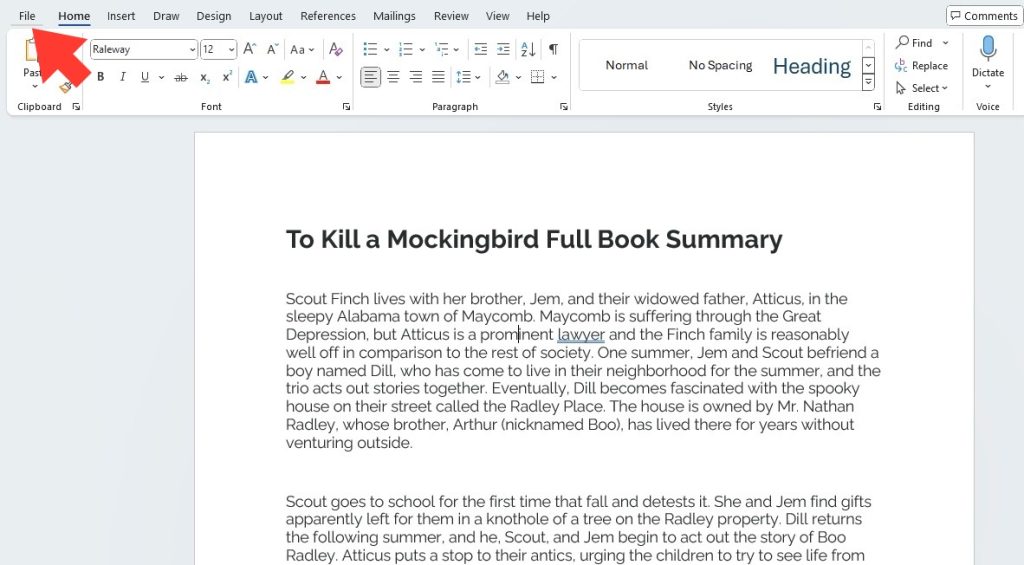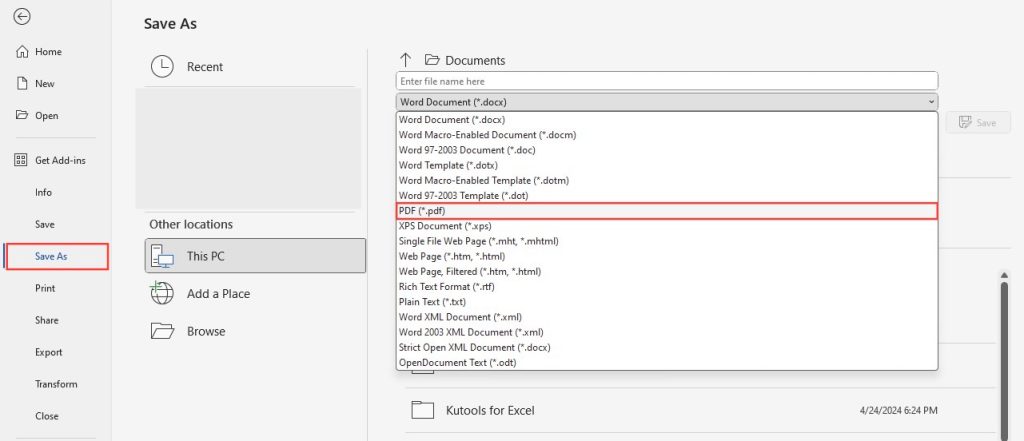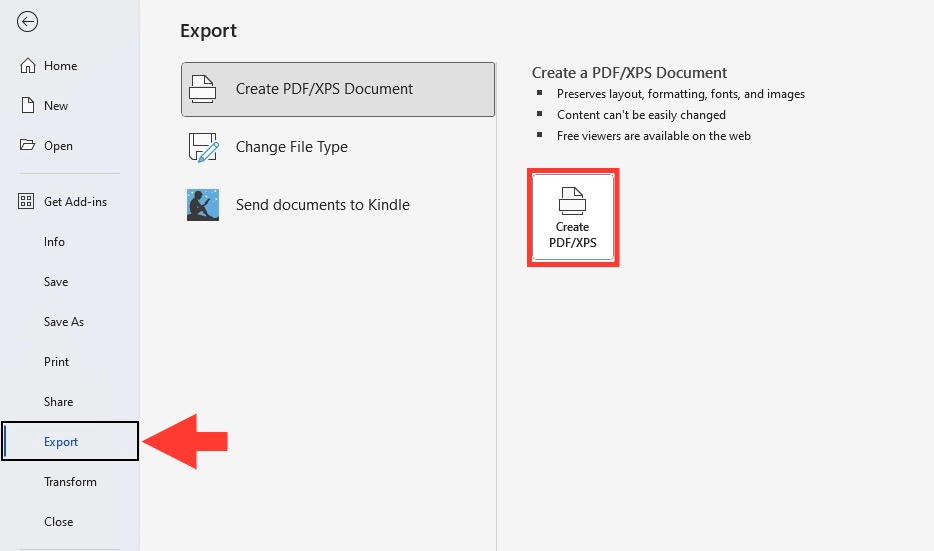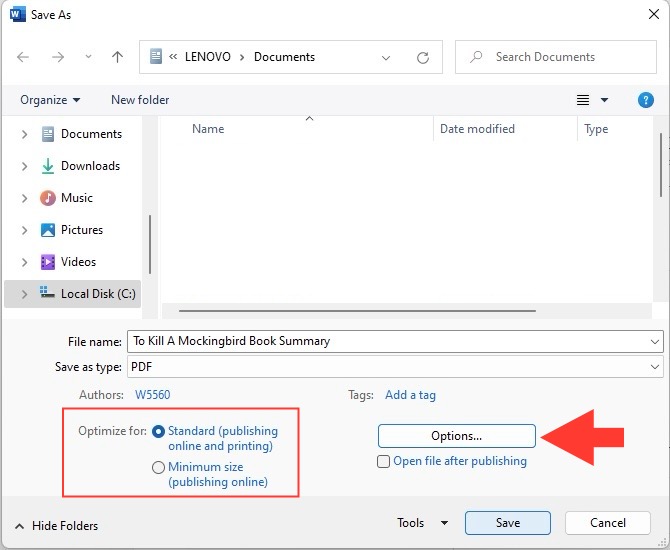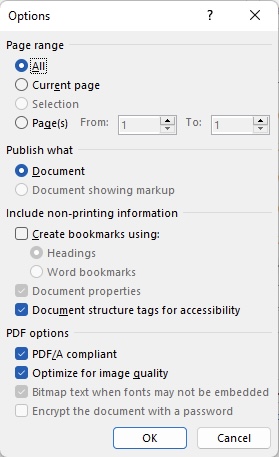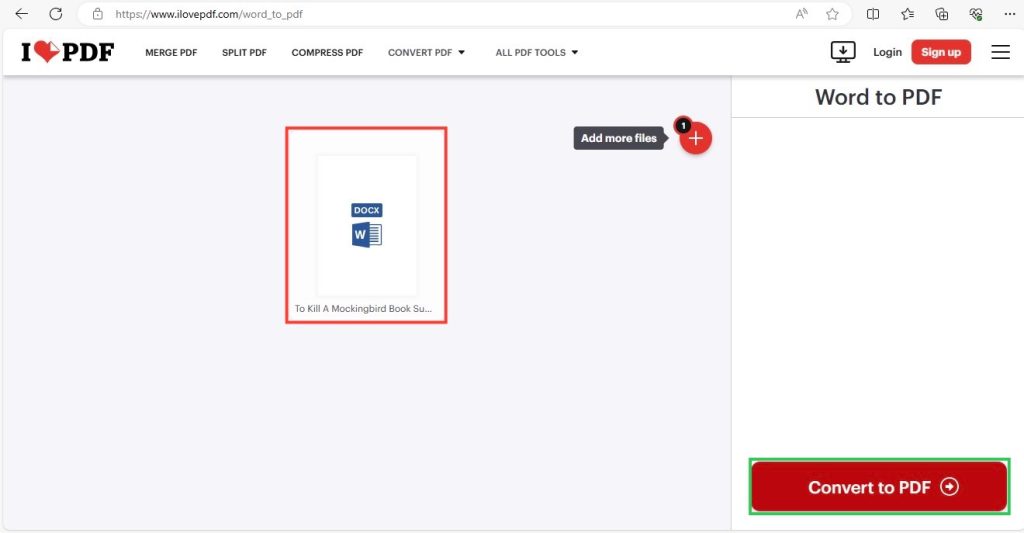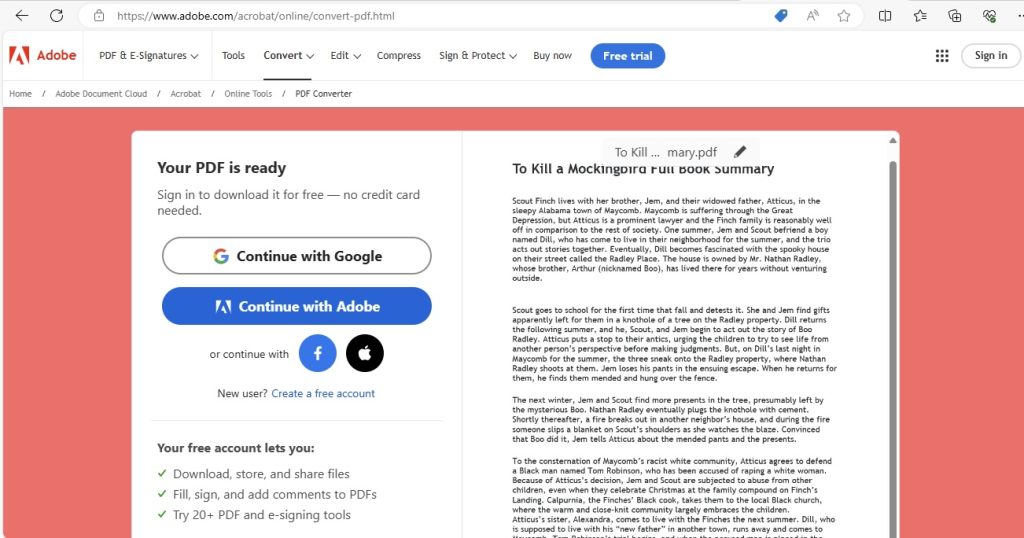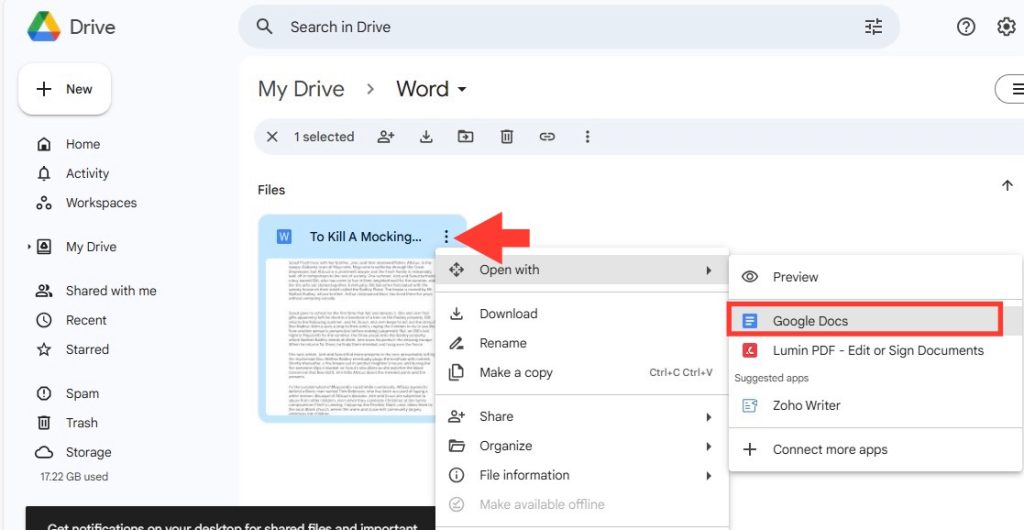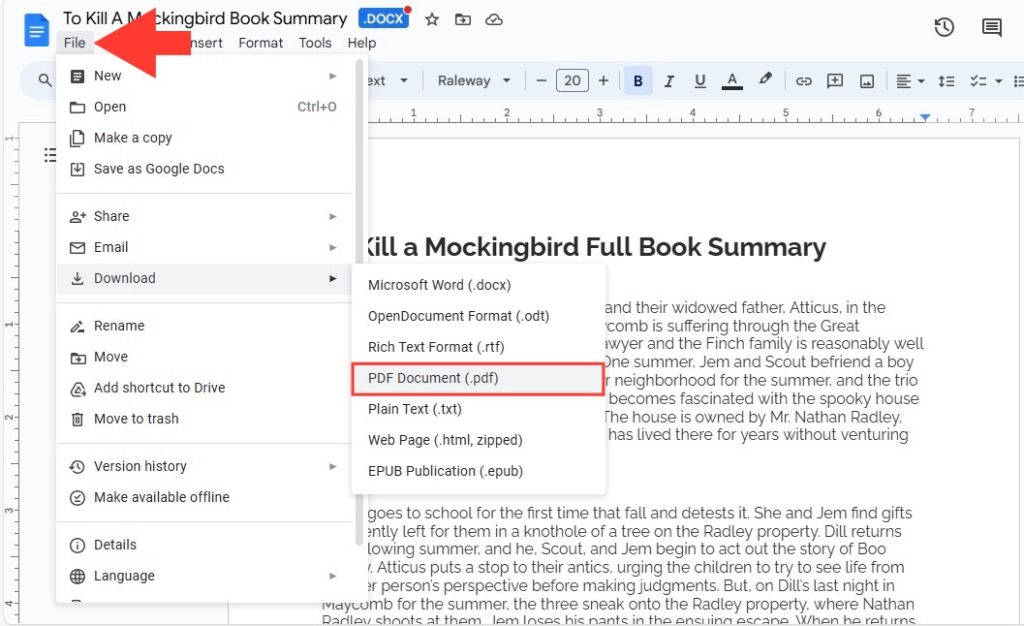

Converting Word files to PDF format offers multiple advantages. A PDF file is often more professional-looking and widely accepted for business purposes. It’s a secure format that is ideal for sharing because it maintains the original design and layout regardless of the device or software being used to view the document. Moreover, PDFs can be password protected, limiting the editing capabilities and thus preserving the document’s integrity.
Learn about Excel with our Free Microsoft Excel Online Course!
Key Takeaways
- Utilize the “Select a file” button or drag and drop feature in Acrobat to easily convert Word documents (RTF, TXT, DOCX, or DOC) into PDF format, then download the newly created PDF.
- For single documents, use Microsoft Word‘s “File” menu to select “Save as” and choose “PDF or XPS” to convert your Word file into a PDF; for multiple documents, employ a Word to PDF converter with batch processing capabilities.
- To ensure proper formatting before conversion, use Word’s Draft view, Show formatting button, Reveal formatting pane, and Navigation pane to identify and fix common issues, guaranteeing the PDF looks consistent across different computers.
Essential Tools for Conversion
To convert Word to PDF, there are several essential tools you can rely on depending on your needs:
- Microsoft Word: It already has a built-in feature to save or export documents as PDFs with just a few clicks.
- Online Conversion Tools: These provide a fast, accessible alternative that works from your browser without the need for software installation.
- PDF Management Software: Programs like Adobe Acrobat offer advanced options for creating and editing PDFs, including Word to PDF conversion.
- PDF Converter Websites: Websites such as [insert-example-website] offer quick conversions with the convenience of cloud storage access.
- Mobile Apps: For those always on the move, mobile apps on Android or iOS allow for easy conversion from Word to PDF right from your smartphone or tablet.
Table of Contents
Step-by-Step Guide for Quick Conversion
Using Built-in Features in Microsoft Word
If you’re using Microsoft Word, converting documents to PDF is a breeze with its built-in features:
STEP 1: Open the Word document you want to convert, click on ‘File’, then select ‘Save As’. In the file format options, choose ‘PDF’ and save your document.
STEP 2: Alternatively, use the ‘Export’ feature by clicking on ‘File’ > ‘Export’, then select ‘Create PDF/XPS Document’ to initiate the conversion.
STEP 3: Before saving, you can adjust the output settings to optimize for print or web to ensure the best PDF quality for its intended use.
STEP 4: Ensure compatibility with other PDF readers by selecting the ‘Standard’ format, which is suitable for most situations.
It’s important to note that while the built-in Microsoft Word feature is convenient, it may not offer as many customization options as third-party tools or dedicated PDF software.
Microsoft Word simplifies PDF conversion with its built-in features:
- Save As PDF: Open your Word document, click on ‘File’, then select ‘Save As’. In the ‘File Format’ drop-down menu, choose ‘PDF’.
- Export to PDF: Access this feature by clicking on ‘File’ > ‘Export’, then select ‘Create PDF/XPS Document’.
These options are built right into Word, providing a seamless conversion without additional software or services. The result is a PDF that maintains the formatting and structure of your original Word document, making it suitable for professional and personal use.
Online Conversion Tools: Fast and Accessible Alternatives
Online conversion tools are incredibly handy for when you don’t have access to Microsoft Word or prefer a quicker alternative without the need to install additional software:
- Accessibility: They are browser-based, meaning you can convert files whether you’re using a PC, smartphone, or tablet—anytime, anywhere.
- Ease of Use: Typically just a few clicks—upload your Word document, hit convert, and download the new PDF file.
- Speed: Many online tools boast impressive conversion speeds, turning documents around in mere seconds.
- No Registration Required: Some platforms don’t require you to create an account or provide any personal information.
- Additional Features: Besides conversion, these tools often offer other PDF-related functionalities like merging, splitting, or securing PDFs.
Websites like iLovePDF and FreeConvert offer conversion services that are straightforward and free. However, always verify the security and privacy policy of online tools to ensure your documents are protected.
Tips for a Smooth Conversion Process
Preserving Formatting and Layouts
When you convert your Word document to a PDF, preserving the formatting and layouts is crucial to maintain its professional appearance and readability:
- Accuracy: The conversion tool should retain the exact structure, including paragraphs, lists, tables, and images, as laid out in the Word document.
- Layout Consistency: Headers, footers, page numbers, and margins should appear identically in the PDF.
- Font Preservation: Ensure that all fonts used in the Word document are embedded during conversion so the PDF looks the same on all devices and platforms.
- Quality of Images: Images should maintain their original resolution and positioning within the document.
Before starting the conversion, review your Word document for any potential formatting issues, like misplaced images or inconsistent fonts, that could be magnified in the PDF.
Ensuring Hyperlink and Metadata Integrity
Maintaining the integrity of hyperlinks and metadata post-conversion ensures your PDF remains interactive and informative:
- Hyperlinks: Check that all internal and external links function correctly after conversion. These should seamlessly guide the reader to the appropriate section or website as they did in the Word document.
- Metadata: This includes the author’s name, document title, subject, keywords, and any other relevant data. It should be correctly transferred and remain editable in the PDF.
Some conversion tools offer advanced settings to customize how hyperlinks and metadata are handled during the conversion. Take a moment to review these settings to ensure they align with your requirements.
Platform-Specific Instructions
Conversion Solutions for Windows Users
Windows users have a plethora of options for converting Word documents to PDF:
- Microsoft Word: As mentioned earlier, utilising the ‘Save As’ or ‘Export’ feature within Word is the most straightforward approach.
- Print to PDF: In Word, select ‘Print’ and choose ‘Microsoft Print to PDF’ as the printer, which creates a PDF version of the document.
- Third-Party Software: Tools like Adobe Acrobat offer more sophisticated features, giving you control over the quality, size, and other PDF attributes.
Explore various solutions to find one that fits your specific needs, whether for simple conversions or complex tasks with multiple files.
Mac Users: Seamless Word to PDF Changes
For Mac users, seamlessly converting Word files to PDF is just as straightforward:
- Word for Mac: Use the ‘File’ > ‘Save As’ option and select ‘PDF’ in the file format choices, or use the ‘Export’ function to create a PDF.
- Preview: Open the Word document with ‘Preview’, go to the ‘File’ menu, and choose ‘Export as PDF’.
- PDFelement for Mac: A versatile tool that not only allows for conversion but also PDF editing and OCR. To convert, run PDFelement, click ‘File’ > ‘New’ > ‘PDF from file’, select your Word document, and hit ‘Save’.
Mac’s ecosystem provides a robust set of tools ensuring your documents are accurately converted while retaining all formatting and design elements.
Mobile Solutions: Convert on the Go
Transforming Word Documents to PDFs on iPhone
Transforming Word documents to PDFs on your iPhone is straightforward, thanks to iOS’s built-in features and dedicated apps:
- Using Files App: In the Files app, locate the Word document, tap it to view, then tap the share icon. Select ‘Print’, pinch open the print preview, and then tap the share icon again to save it as a PDF.
- Using Microsoft Word App: Open the document in the Word app, tap the three dots icon for more options, and select ‘Print’. From there, you can choose ‘Save as PDF’ and save it directly to your device or cloud storage.
These solutions allow you to convert documents without any additional software downloads, directly leveraging the benefits of iOS’s integrated features.
Android Apps That Make Conversion Easy
For Android users, converting Word documents to PDFs can be effortlessly accomplished with the right app:
- Microsoft Word: Just like on your PC, run Word, open the document, tap the overflow menu (three dots), and choose ‘Print’ > ‘Save as PDF’.
- WPS Office: With its huge user base, this app is reliable for document conversion. Open your Word file, tap the ‘Tools’ icon, select ‘PDF’, and then convert your file with ease.
- Google Drive: You can upload the Word file to Drive, open it with Google Docs, and then download it as a PDF.
Each app provides a unique set of features and interfaces, allowing you to choose one that best suits your needs for productivity on the go.
Troubleshooting Common Issues
Addressing Compatibility Problems
To tackle compatibility issues during Word to PDF conversion:
- Update Your Software: If you’re getting conversion errors, make sure that your Word and PDF reader software are up to date with the latest versions.
- PDF Standards:Choose the correct PDF standard (e.g., PDF/A for archiving) to ensure compatibility across various devices and PDF readers.
- Use Trusted Tools: Stick to well-known conversion tools known for maintaining high compatibility with different systems and software versions.
Remember that the more complex your Word document (e.g., with macros or embedded content), the greater the potential for compatibility challenges.
Dealing with Large File Sizes During Conversion
When you’re faced with large file sizes during conversion:
- Optimize Images: Before conversion, reduce the resolution of images in the Word document if they are not required to be in high definition for the PDF.
- Remove Unnecessary Elements: Get rid of any non-essential content from your Word document that could bulk up the file size.
- Use Compression Tools: Post-conversion, utilize PDF compressing tools to shrink the file size without compromising too much on quality.
Check if your conversion software provides options to compress and optimize the PDF during the conversion process.
FAQs About Word to PDF Conversion
Can I Convert Word to PDF Without Software Installation?
Yes, you can convert a Word document to a PDF without installing any software. Many online conversion tools allow you to convert files directly through your web browser. Simply upload your document to the online converter, and then download your PDF file once the conversion is complete. It’s a user-friendly and quick solution for occasional use or when on a device where you cannot install software.
How Do I Maintain Fonts and Images When Converting?
To maintain fonts and images during conversion, ensure that you embed all fonts when saving or exporting from Word to PDF. This includes selecting the ‘Embed Fonts‘ option in Word’s advanced save settings. Moreover, for images, verify that they are inserted and not linked, and that their resolution is suitable for your PDF purposes. High-resolution images will look better but increase the file size. Use a reputable conversion tool that maintains the quality of images and consistency of fonts.
Is There a Way to Batch Convert Multiple Word Files to PDF?
Yes, there are ways to batch convert multiple Word files to PDF. Several tools offer this functionality, like Adobe Acrobat, which provides the option to convert multiple files at once. For a free alternative, UPDF is a tool that supports batch processing; you can add multiple Word files and convert them with a single click. Such features are excellent for efficiency when dealing with a large number of documents, especially in a workplace setting.
Can I Convert Word to PDF Offline?
Absolutely! You can convert Word documents to PDF offline using various methods:
- Microsoft Word: The desktop version includes built-in options to save or export documents as PDFs without needing an internet connection.
- PDF Printer: Most operating systems include a ‘Print to PDF’ feature that allows you to ‘print’ your documents directly to a PDF file.
These offline methods are excellent for maintaining your privacy and ensuring that your documents can be converted wherever and whenever you need them.
How Do I Ensure My Converted PDF Looks the Same as the Word File?
To ensure your PDF looks identical to the original Word file:
- Use Quality Conversion Tools: Choose reliable software or online services known for maintaining document fidelity.
- Pre-Conversion Check: Go through your Word document to confirm all elements are properly formatted and displayed.
- Post-Conversion Review: After converting, compare the PDF to the Word document to ensure that the formatting has been preserved.
These steps will help you to maintain the integrity of your document’s design and content throughout the conversion.
Are Online Word to PDF Tools Safe to Use?
Yes, many online Word to PDF tools are safe, providing they use secure connections:
- Encryption: Look for tools that use SSL encryption to protect your data during transfer.
- Privacy Policy: Review the service’s privacy policy to confirm they don’t store or share your files.
- Data Handling: Choose services that automatically delete your files after conversion.
Always perform due diligence on an online tool’s security measures to ensure the protection of your sensitive information.
What If I Don’t Have Microsoft Word?
If you don’t have Microsoft Word, fret not—you still have options:
- Google Drive: Upload your document to Google Drive, open it as a Google Doc, and then download it as a PDF.
- Online Converters: Use a reputable online conversion service like to easily convert your files without Word.
- Alternative Office Suites: Consider free office suites such as LibreOffice or OpenOffice, which offer PDF export functions.
These methods provide flexibility and ensure that you can convert documents to PDF even without the Microsoft suite.


John Michaloudis is a former accountant and finance analyst at General Electric, a Microsoft MVP since 2020, an Amazon #1 bestselling author of 4 Microsoft Excel books and teacher of Microsoft Excel & Office over at his flagship MyExcelOnline Academy Online Course.


